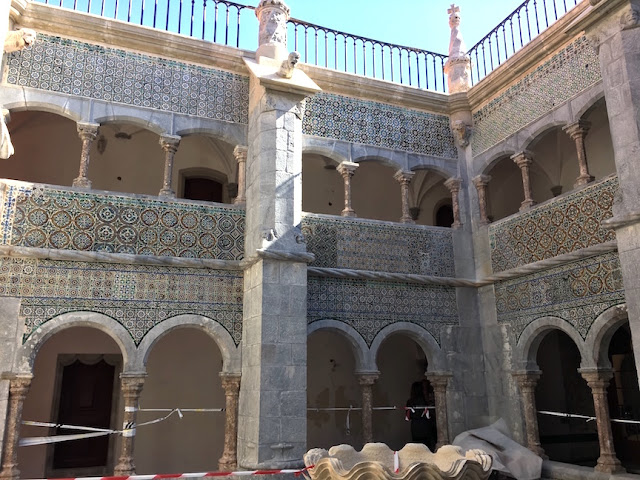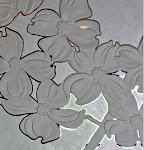Sintra
is a town and a region in the hills in the greater metropolis of
Lisbon. We arranged for a guided tour so on Saturday our guide picked
us up about 8:30 for the drive to Sintra and our first stop at what
he called the most beautiful castle in Portugal, the Palace of Pena, at the top of the tallest hill on a twisty road through a beautiful forest. And he was
right. It is gorgeous. Built around a monastery dating from 1511 and
abandoned in 1834, King Ferdinand refurbished the monastery for a
holiday retreat and then added a new wing in the mid 1800s. At the
same time, he ordered the empty hillsides to be planted with trees
from all over the world and with gardens and winding paths. The hill is
now forested with over 500 different trees. Link for more info. The
palace reflects influences from the Moors, the Templars, and German romanticism.
The red section is the old palace built from the monastery and the
yellow and tiled section is the new palace.
the
Neptune gate
some
of the elaborate detail is carved stone
some
is carved wood
some
is trompe l'oeil
a
niche tiled with sea shells, a space for monks to meditate in
solitude
view
from an upper terrace
After
touring the castle our guide gave us an hour to wander the town
Portuguese
pottery, I regret now not bringing back at least a small plate
before we headed to the beach for a really nice lunch at a family run
hotel and then off to the western most point of Europe.
We
returned to Lisbon driving along the shore and passed under the
aqueduct started in 1731 and though still unfinished began bringing water to Lisbon in 1745. In 1755, a devastating earthquake
struck Lisbon destroying the city but not one stone was lost from the
aqueduct. Modern engineers still claim the aqueduct over the
Alcantara Valley couldn't have been built, especially the largest pointed arch, but there it stands.
image
via Wikipedia
The
last point of interest our guide showed us before dropping us back at the apartment was the last remaining
section of the defensive wall built by the Moors when they occupied
the southern part of Portugal in the 8th
century, finally being defeated by King Alfonso in the mid 12th
century.
last:
azulejo, the Portuguese tiles
previous:



























Oh my GOD! How did they even conceive of such a structure? I'm talking about the castle but the aqueduct as well. Just...sometimes I truly believe that the human race peaked a while back. In some ways, at least. I never realized how many different influences Portugal contains. Frankly, I've never really even though much about Portugal. Isn't that crazy?
ReplyDeleteme either. it's like the hidden jewel of Europe. and I think you're right, the human race peaked centuries ago.
DeleteThat castle is beyond simple description. Think of the legions of artisans employed. Ferdinand was the Trump of his time, and the artisans went to their graves begging payment for their work. Including the poor sods who brought in all the trees and dirt and dug all the holes. As lovely as it all is, and awesome and "inspiring", like much of the existing world, it is built on the backs of the masses who were not paid a day's wage for a day's work. End of rant.
ReplyDeleteBeautiful! I didn't make it to Sintra when I visited Lisbon, so it's nice to see what I missed! Those colors are amazing.
ReplyDeleteThank you so much for sharing your journey with us - it's just been amazing!
ReplyDeleteI just had to keep l;ooking back and forth on these pictures. What a gem to have found, I have never seen anything so beautiful!
ReplyDeleteOk, spending all day with this post. Thanks. Such a glorious place! Using some photos for screen savers. Astonishing and so well photographed, LOVE
ReplyDeleteI've actually been there, years ago. Thanks for giving me a return trip. I loved Portugal.
ReplyDelete